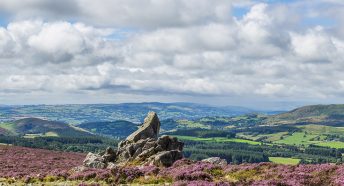Step into history with these pilgrims' walking routes
Landscape photographer and author Derry Brabbs has captured some of the world’s most spectacular pilgrim routes. Here, he explains how following in the footsteps of pilgrims can be an eye-opening experience for any walker.
Fancy a walk through some of England’s finest countryside? Better still, how about making it a walk with a purpose – and go on a pilgrimage? The tradition of journeying on foot to significant religious sites, currently enjoying a resurgence in predominantly Catholic countries of Europe, is also becoming increasingly popular on this side of the Channel.
Of course, a pilgrimage does not necessarily have to be a religious journey – that depends entirely on the individual undertaking it. But the start and finish of a traditional route will of course be at a church or cathedral. I never tire of marvelling at the art and architecture of our Romanesque and Gothic churches, wondering just how it was all achieved with so few of the technical aids we take for granted today. Setting oneself the goal of following an itinerary day after day, until the destination is reached, can be a surprisingly rewarding achievement, despite the occasional blister!
St Cuthbert’s Way
Few places exhibit the spirit of early Christianity as much as Lindisfarne (Holy Island), and visitors somehow become enveloped in the timeless atmosphere that pervades the island, including the ruins of the 12th-century priory. Depending on one’s chosen direction of travel along St Cuthbert’s Way, this early Christian monastic site represents either a truly inspirational starting point for a pilgrimage across Northumbria to the Scottish Border, or a fitting conclusion to an epic journey.
Opened in 1996, St Cuthbert’s Way was brought to fruition in just 18 months, following laudable cooperation from public bodies and landowners to facilitate the creation of paths where no public rights of way had previously existed. It was a fine example of how bureaucratic process need not drag on interminably if there is a will to succeed.
Visit the St Cuthberts Way website to plan your walk
The Pilgrims’ Way
This 119-mile route runs from the shrine of St Swithun in Winchester Cathedral across the glorious landscapes of southern England, before arriving at Canterbury Cathedral. The distant view of the cathedral across the rooftops of the old city must have brought joy and relief to medieval pilgrims.
Another highlight of the Pilgrims’ Way is undoubtedly St-Martha-on-the-Hill, a church set amid the woodland of the Surrey Hills to the south-east of Guildford, and not accessible by car. Walkers can relax on a strategically sited bench with its own sandy beach. An aura of peace and tranquillity pervades the site, which has been occupied by a place of Christian worship since Saxon times.
Head to the Pligrims’ Way website and plan your trip
The Walsingham Way
The village of Walsingham in Norfolk has a legacy of pilgrimage dating back to the Middle Ages. At one point it actually surpassed Canterbury as the nation’s most important place of pilgrimage, thanks to its dedication to the Virgin Mary.
Even more surprising is the fact that there are both Catholic and Anglican shrines in the village. Today, a great ruined arch is all that remains of the medieval priory of Our Lady of Walsingham. In 2021, a new fully waymarked route between Norwich and Walsingham was launched.
Visit the Walsingham Way website and plan your walk
So, fancy taking a ramble with meaning? Strap on those boots, follow in the footsteps of devout walkers before you – and let us know how you get on on our Facebook, Twitter and Instagram pages!







